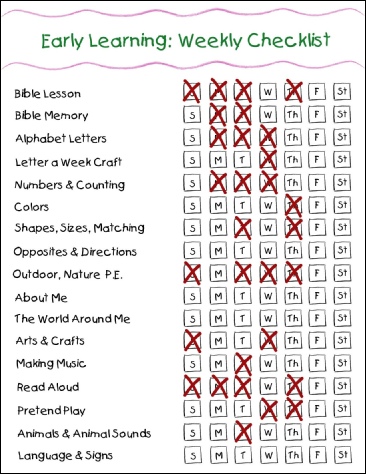

Search This Site
Follow by Email
Sign Up
Don't worry, we hate spam too, and promise to keep your email private!

Online Health Consultations



Home > Homeschool > Early Learning > Early Learning Planners and Checklist
Early Learning Planners and Checklist
This weekly checklist, and other organizational tools, make it possible to keep track of what your student is learning while also leaving a lot of room for flexibility.
Perfect for the home educators who enjoy piecing together their own curriculum and create very personalized lesson plans.
>> Download the Early Learning Weekly Checklist Now <<
How to Use This Weekly Checklist
I designed this checklist to give as much flexibility as possible. Obviously we are not going to be doing every one of these subjects everyday, and I’m certainly not planning to do school seven days a week.
Instead of being a checklist that dictates to us what we have to do, this checklist is more designed to help us keep track of what we’ve already done.
You, as the teacher, can decide how much of each topic you feel your child needs to do in a given week, and as you check off the different things you’ve engaged in with your child you can see clearly whether the amount you have done is satisfactory or not.

Here is an example of how the checklist can work. You can easily mark off the subjects you’ve done, and as you near the end of the week and you look back to see what subjects you have been doing really well in and which subjects you need to focus on more intentionally in the final days or in the week ahead.
You can either print off several copies of this Early Learning Weekly Checklist,
or you would prefer to save on paper you could just print one single copy and have
it laminated so you can use it with dry-
Organizing the Individual Classes
At first glance, it may seem like a lot of classes for your young student(s), but it’s not really as overwhelming as it may seem.
The best part about the Early Learning Activities and Subjects is that a single activity can often count for multiple subjects!
So if you did an outdoor activity that also included some artistic flare (such as the Nature Art) you could easily check off both the “Outdoor, Nature” subject as well as the “Arts & Crafts” subject, both from this one single activity.
Or even some of the children’s videos (like Richard Scarry’s Best Learning Songs
Video Ever) touches on several different subjects, and while you may want to supplement
a few of those subjects with other hands-
I have created a Weekly Overview Planner that can help you organize the activities you plan to do with your child in a given week. Here is an example of how the planner can be used:


>> Download the Weekly Overview Planner Now <<
Weekly Themes
You’ll notice on the Weekly Overview Planner that there is a space for writing in the week’s “theme”. Choosing a weekly theme is a great way to stay focused and make lesson planning so much easier.
What I like to do is to follow the alphabet when planning out our weekly lesson plans, so that each week has the theme of a different letter of the alphabet:
Letter of the Week: D
Letter of the Week: E
Letter of the Week: F
Letter of the Week: G
Letter of the Week: H
Letter of the Week: I
Letter of the Week: J
Letter of the Week: K
Letter of the Week: L
Letter of the Week: M
Letter of the Week: N
Letter of the Week: O
Letter of the Week: P
Letter of the Week: Q
Letter of the Week: R
Letter of the Week: S
Letter of the Week: T
Letter of the Week: U
Letter of the Week: V
Letter of the Week: W
Letter of the Week: X
Letter of the Week: Y
Letter of the Week: Z
Following these themes for each week makes it very simple to plan out activities to do with my child because the theme helps me to stay focused and not to get lost or overwhelmed with the countless preschool resources that are available.
Calendar of Themes
If you want to plan out your weekly themes for the year here is a nice printable planner for that . . .
>>Download the Calendar of Themes Now<<
Attendance and Hour Tracker Charts
If your state requires you to keep track of the days and/or hours of your homeschool (or even if you prefer to do it for your own benefit) you can use these charts to make that tasks really simple . . .
>> Download the Attendance Chart Now <<
>> Download the Hour Tracker Now <<
And while we’re on the topic of getting organized, here are a few tips and resources that may be helpful to you:
1) Printing
Most of the FREE resources available online require the use of a printer, and printing tons of pages each week can get pretty expensive (especially if you’re paying $20+ per ink cartridge. To help save money, our family invests in a really good printer that has the option of buying generic ink for REALLY CHEAP!! Don’t get me wrong, the quality of the printing is not reduced by any means. The printer does really top quality printing, but very easy on the budget!
Here is an article I wrote as a review on the printer we use: Best Printer Ever
2) Laminating
To save on the amount of pages you need to print, I would highly recommend getting a laminator and laminating any sheets you could use multiple times. Daily schedules, teacher checklists, student worksheets, etc. You can use washable markers (or dry erase markers) for writing on the pages. Then, wipe them clean and they’ll be ready to use another day!
3) SaveFromNet
There are a lot of great educational shows on YouTube, but did you know that it’s possible (and even very simple) to download YouTube videos for offline viewing?! Just browse to the SaveFromNet website and copy the web address of whatever YouTube video you are wanting to download.
For me, I like to download videos for my children and copy them onto their Kindle Fire . . . then they don’t have to be on the internet at all, and they can go off and watch their movies without tying up my computer. Works great for us!
Note: There is an option to download the SaveFromNet software, but I never do. You can download directly from the website without having to install any programs.
I hope you’ve enjoyed these resources. Be sure to check our other Early Learning
subjects for great ideas for homeschooling the “early years” (Pre-




